BunkerBoy Trend Triggered after Protesters Force Trump to Hide in Underground Bunker
June, 01, 2020 -
TEHRAN (Tasnim) – A huge #BunkerBoy trend was triggered on Twitter after the US President Donald Trump was rushed to an underground bunker on Friday along with his wife and son, Barron amid the massive George Floyd protest in front of the White House
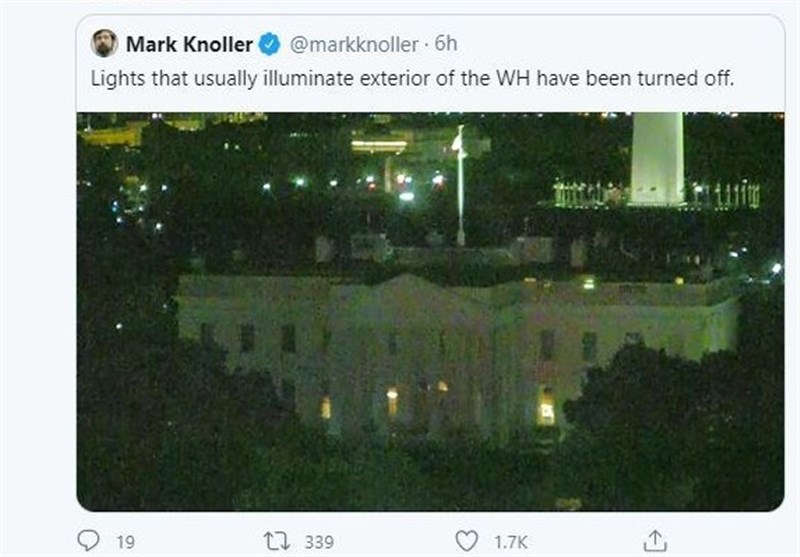
Trump was moved to the secure location by the Secret Service, according to reports by the New York Times and Associated Press. According to AP, the US president spent about an hour in the facility, which is designed to be used in case of a physical threat to senior executive officials.
Both reports make it clear that the decision to move Trump into the bunker was taken by the Secret Service. The image of the man hiding from the people’s wrath like some despot on the verge of being toppled was too appealing for his many detractors to miss.
The #Resistance side of Twitter had a field day snickering about how the president was hiding underground from a bunch of 20-year-olds.
Following the allegations in the media, the hashtag #BunkerBoy started trending on Twitter, adding more fuel to the fire in relations between the sitting US president and the public.
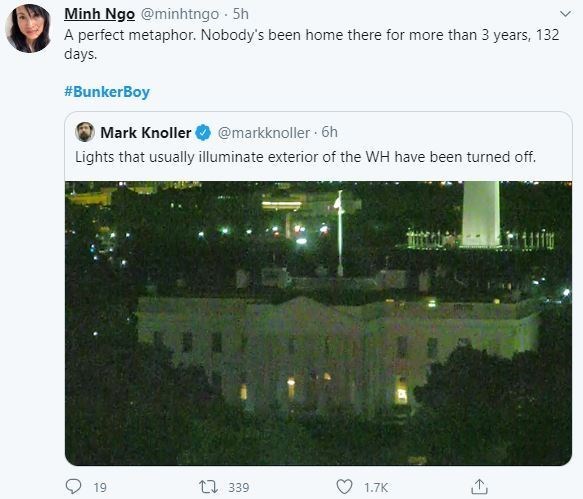
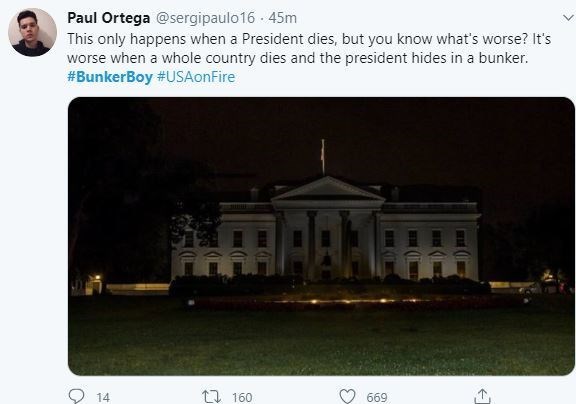
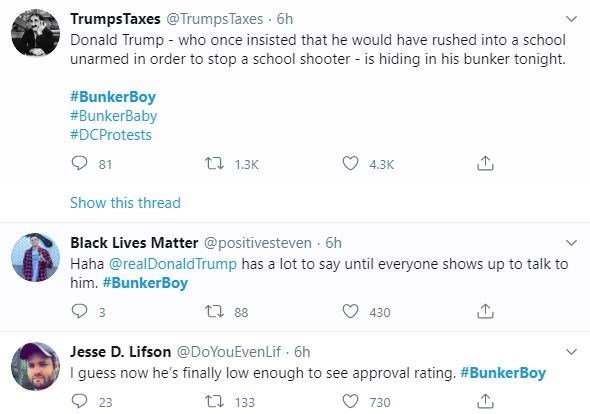
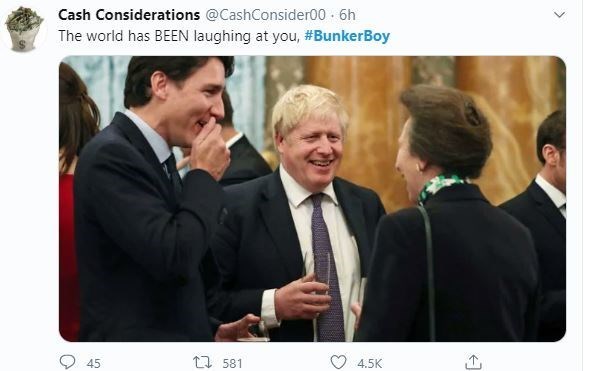
Share this story:
https://tn.ai/2277621
Trump Took Shelter in White House Bunker As Protests Raged
TEHRAN (Tasnim) – Secret Service agents rushed US President Donald Trump to a White House bunker on Friday night as hundreds of protesters gathered outside the executive mansion, some of them throwing rocks and tugging at police barricades.
June, 01, 2020 - 11:38
Trump spent nearly an hour in the bunker, which was designed for use in emergencies like terrorist attacks, according to a Republican close to the White House who was not authorized to publicly discuss private matters and spoke on condition of anonymity. The account was confirmed by an administration official who also spoke on condition of anonymity.
The abrupt decision by the agents underscored the rattled mood inside the White House, where the chants from protesters in Lafayette Park could be heard all weekend and Secret Service agents and law enforcement officers struggled to contain the crowds.
Friday's protests were triggered by the death of George Floyd, a black man who died after he was pinned at the neck by a white Minneapolis police officer. The demonstrations in Washington turned violent and appeared to catch officers by surprise. They sparked one of the highest alerts on the White House complex since the Sept. 11 attacks in 2001.
“The White House does not comment on security protocols and decisions,” said White House spokesman Judd Deere. The Secret Service said it does not discuss the means and methods of its protective operations. The president's move to the bunker was first reported by The New York Times.
The president and his family have been shaken by the size and venom of the crowds, according to the Republican. It was not immediately clear if first lady Melania Trump and the couple’s 14-year-old son, Barron, joined the president in the bunker. Secret Service protocol would have called for all those under the agency's protection to be in the underground shelter.
Trump has told advisers he worries about his safety, while both privately and publicly praising the work of the Secret Service.
Trump traveled to Florida on Saturday to view the first manned space launch from the US in nearly a decade. He returned to a White House under virtual siege, with protesters — some violent — gathered just a few hundred yards away through much of the night.
Demonstrators returned Sunday afternoon, facing off against police at Lafayette Park into the evening.
Trump continued his effort to project strength, using a series of inflammatory tweets and delivering partisan attacks during a time of national crisis.
As cities burned night after night and images of violence dominated television coverage, Trump’s advisers discussed the prospect of an Oval Office address in an attempt to ease tensions. The notion was quickly scrapped for lack of policy proposals and the president’s own seeming disinterest in delivering a message of unity.
Trump did not appear in public on Sunday. Instead, a White House official who was not authorized to discuss the plans ahead of time said Trump was expected in the coming days to draw distinctions between the legitimate anger of peaceful protesters and the unacceptable actions of violent agitators.
On Sunday, Trump retweeted a message from a conservative commentator encouraging authorities to respond with greater force.
“This isn’t going to stop until the good guys are willing to use overwhelming force against the bad guys,” Buck Sexton wrote in a message amplified by the president, AP reported.
In recent days security at the White House has been reinforced by the National Guard and additional personnel from the Secret Service and the US Park Police.
On Sunday, the Justice Department deployed members of the US Marshals Service and agents from the Drug Enforcement Administration to supplement National Guard troops outside the White House, according to a senior Justice Department official. The official could not discuss the matter publicly and spoke on condition of anonymity.
The Double Standard of the American RiotKELLIE CARTER JACKSON THE ATLANTIC
![]()
The nationwide protests against police killings have been called un-American by critics, but rebellion has always been used to defend liberty.
Those who rebuke violent responses to injustice should ask themselves: How should the oppressed respond to their oppressors? (Phobymo)
Since the beginning of this country, riots and violent rhetoric have been markers of patriotism. When our Founding Fathers fought for independence, violence was the clarion call. Phrases such as “Live free or die,” “Give me liberty or give me death,” and “Rebellion to tyrants is obedience to God” echoed throughout the nation, and continue today. Force and violence have always been used as weapons to defend liberty, because—as John Adams once said in reference to the colonists’ treatment by the British—“We won’t be their Negroes.”

Black rebellion and protest, though, have historically never been coupled with allegiance to American democracy. Today, peaceful demonstrations and violent riots alike have erupted across the country in response to police brutality and the killings of George Floyd, Breonna Taylor, and Ahmaud Arbery. Yet the language used to refer to protesters has included looters, thugs, and even claims that they are un-American. The philosophy of force and violence to obtain freedom has long been employed by white people and explicitly denied to black Americans.
Think back to March 5, 1770, when Crispus Attucks, a man of African and Native American descent, became the first casualty of the American Revolution. Attucks was one of a handful of protesters killed by British forces during the Boston Massacre. The lawyer tasked with defending the British soldiers in their American criminal trial was none other than Adams. When presenting his case, Adams described the men those soldiers killed as “a motley rabble of saucy boys, negroes and molattoes [sic], Irish teagues and outlandish jack tarrs.” He built his defense of the British soldiers on the charge that Attucks struck the first blow and led the “dreadful carnage.” Adams concluded that the “mad behavior” of Attucks provoked the soldiers’ response, saying that Attucks’s group was “under the command of a stout molatto fellow, whose very looks, was enough to terrify any person.” Some 250 years later, Adams’s words still underline a central truth in American disobedience: Freedom through violence is a privilege possessed only by whites. Seminal moments in U.S. history that historians have defined as patriotic were also moments that denied patriotism to black people.
Read: When police view citizens as enemies
If violence is a political language, white Americans are native speakers. But black people are also fluent in the act of resistance. Attucks stood up to British tyranny. The numerous slave rebellions led by Gabriel Prosser, Charles Deslondes, and Nat Turner were all attempts to gain freedom with force. Throughout the 20th century, black Americans armed themselves in the face of white mobs and organized protection for their freedom marches. Accordingly, when George Floyd, Breonna Taylor, and so many others were killed by police, black people and their allies chose to rise up.![]() Protests at Philadelphia City Hall on May 30, 2020 (Phobymo)
Protests at Philadelphia City Hall on May 30, 2020 (Phobymo)
Americans like to harken back to the civil-rights era as a moment of nonviolence and civil disobedience. But that movement was an orchestrated response to violence. Violence at the voting booth. Violence at the lunch counter. Violence that bombed a church with four little black girls inside. Violence that left a bloated black boy in an open casket. Violence that left a black husband and father murdered in his driveway. The movement ended with the violent death of Martin Luther King Jr. And his death ignited riots in more than 100 cities.
Read: The American nightmare
It is easy to dismiss the rock thrower; Attucks himself was accused of throwing sticks. But those who rebuke violent responses to injustice should ask themselves: How should the oppressed respond to their oppressors? How should the nation respond to political dissent? How do the oppressed procure power? Throughout history, black people have employed violence, nonviolence, marches, and boycotts. Only one thing is clear—there is no form of black protest that white supremacy will sanction. Still, black people understand the utility of riotous rebellion: Violence compels a response. Violence disrupts the status quo and the possibility of returning to business as usual. So often the watershed moments of historical record are stamped by violence—it is the engine that propels society along from funerals to fury and from moments to movements.

![]() In December 1866, the famed abolitionist Frederick Douglass wrote an essay for The Atlantic in which he reflected on the benefits of rebellion: “There is cause to be thankful even for rebellion. It is an impressive teacher, though a stern and terrible one.” He then concluded, “The thing worse than rebellion is the thing that causes rebellion.” Many people are asking if violence is a valid means of producing social change. The hard and historical answer is yes. Riots have a way of magnifying not merely the flaws in the system, but also the strength of those in power. The American Revolution was won with violence. The French Revolution was won with violence. The Haitian Revolution was won with violence. The Civil War was won with violence. A revolution in today’s terms would mean that these nationwide rebellions lead to black people being able to access and exercise the fullness of their freedom and humanity.The other night, I was watching the copious news coverage of the protests. I wanted to be out there. I felt helpless. But I’d just had a baby and had no business being out in the streets. I called my mother for encouragement. She said, “I was in college during all of the ’68 riots. Just keep on living; there’ll be another chance.” History has taught me she is likely right. A riot may be temporary violence, quick and dirty, but it could become a revolution. And though slow and long-lasting, when it is fully mature, a revolution is irrefutable change.KELLIE CARTER JACKSON is an assistant professor of Africana studies at Wellesley College, and the author of Force and Freedom: Black Abolitionists and the Politics of Violence.
In December 1866, the famed abolitionist Frederick Douglass wrote an essay for The Atlantic in which he reflected on the benefits of rebellion: “There is cause to be thankful even for rebellion. It is an impressive teacher, though a stern and terrible one.” He then concluded, “The thing worse than rebellion is the thing that causes rebellion.” Many people are asking if violence is a valid means of producing social change. The hard and historical answer is yes. Riots have a way of magnifying not merely the flaws in the system, but also the strength of those in power. The American Revolution was won with violence. The French Revolution was won with violence. The Haitian Revolution was won with violence. The Civil War was won with violence. A revolution in today’s terms would mean that these nationwide rebellions lead to black people being able to access and exercise the fullness of their freedom and humanity.The other night, I was watching the copious news coverage of the protests. I wanted to be out there. I felt helpless. But I’d just had a baby and had no business being out in the streets. I called my mother for encouragement. She said, “I was in college during all of the ’68 riots. Just keep on living; there’ll be another chance.” History has taught me she is likely right. A riot may be temporary violence, quick and dirty, but it could become a revolution. And though slow and long-lasting, when it is fully mature, a revolution is irrefutable change.KELLIE CARTER JACKSON is an assistant professor of Africana studies at Wellesley College, and the author of Force and Freedom: Black Abolitionists and the Politics of Violence.
Trump Will Mobilize US Military to Put Down Violent Protests Nationwide
The president said he was already dispatching “thousands and thousands of heavily armed soldiers, military personnel and law enforcement officers” in Washington, D.C.
J. Clara Chan | June 1, 2020
President Donald Trump threatened to deploy the U.S. military to extinguish protests around the country if cities or states do not do what’s “necessary to defend the life and property of their residents.”
“If a city or state refuses to take the actions that are necessary to defend the life and property of their residents, then I will deploy the United States military and quickly solve the problem for them,” Trump said before reporters on Monday. “I am mobilizing all available federal resources, civilian and military, to stop the rioting and looting, to end the destruction and arson, and to protect the rights of law-abiding Americans, including your Second Amendment rights.”
Trump called on governors to utilize the National Guard, which the president said he wanted to “dominate the streets” across the country. In Washington, D.C., Trump said he was already dispatching “heavily armed” forces.
“As we speak, I am dispatching thousands and thousands of heavily armed soldiers, military personnel and law enforcement officers to stop the rioting, looting, vandalism, assaults and the wanton destruction of property,” he said. “We are putting everyone on warning. Our 7 o’clock curfew will be strictly enforced.”
Also Read:Trump Advocates for 'Retribution' Against Protesters in Call With Governors
The president left without taking any questions. He then walked to St. John’s Church holding a Bible, but law enforcement officials fired tear gas and rubber bullets into a crowd of peaceful protesters to clear a path.
Protests across the country have continued this week in response to the killing of George Floyd. Though many of the protests have been peaceful, police have violently clashed with protesters in numerous cities, frequently using tear gas, rubber bullets and arresting hundreds. In Los Angeles, businesses across the county have also been vandalized and looted by some demonstrators.
Earlier on Monday during a private call with the country’s governors, Trump advocated for “retribution” against protesters, whom he called “terrorists,” “anarchists” and “radicals,” and said governors needed to “dominate” them.
“It’s a movement. If you don’t put it down it will get worse and worse,” Trump said, according to a recording of the call obtained by the New York Times. “The only time they’re successful is when you’re weak. And most of you are weak.”
“Someone throwing a rock is like shooting a gun. You have to do retribution,” he also said.
Last week, Trump also faced pushback for tweeting and writing in a Facebook post, “When the shooting starts, the looting starts” — a phrase with a racist historical context. Twitter placed a content-warning label on the tweet for “glorifying violence,” but Facebook’s Mark Zuckerberg said his platform wouldn’t remove or otherwise mark the post because “people need to know if the government is planning to deploy force.”








